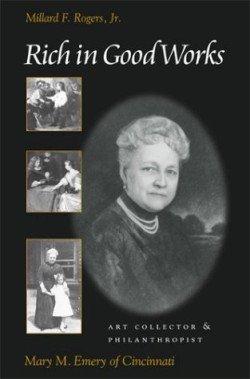Rich in Good Works
Mary M. Emery of Cincinnati
News reports and short fictionalized accounts about the moneyed class offer a slim look into the lives of the wealthy, and sometimes only serve to reinforce stereotypical ideas that prevail with regard to the rich. For readers in search of both an explicit examination of an affluent life and a main character of absolute character, there is Rich in Good Works.
This book is a skillfully rendered full-length portrait of Mary M. Emery, a woman reared in an environment of middle-class values who lived to become a remarkable humanitarian in disbursing her wealth for the betterment of society. Born on Dec. 19, 1844 in New York City and married on May 24, 1866 in Cincinnati to Thomas J. Emery, a bashful Mary M. Emery became part of the elite class, traveled abroad, and suffered tragic losses with the death of both of her sons, and later, her husband in 1906.
As heir to a fortune amassed by her husband through land acquisitions and construction of residential and commercial buildings in Cincinnati, not to mention operation of an income-rich oil and candle factory near the Ohio River, Emery embarked on a path that most likely bewildered and delighted critics of the wealthy at the time-she embraced philanthropist Andrew Carnegie’s creed that surplus wealth “is a sacred trust” to be administered “by its possessor for the best good of his fellow-men.”
During the two decades after her husband’s death, Emery, guided by surrogate son and advisor Charles J. Livingood, contributed a total of more than twenty million dollars to a long list of causes and organizations. “Ambition for my children was denied me, yet I had them long enough to know and sympathize with all youth and its struggles in the world,” she wrote in a letter to American author Dorothy Canfield Fisher. Emery demonstrated her empathy for the young with contributions such as $250,000 to the University of Cincinnati Medical School, Department of Pediatrics; $565,000 to YMCA Central in Cincinnati; and $1.5 million to the Ohio Mechanics Institute and Emery Auditorium in Cincinnati.
The Cincinnati Art Museum, as well as a planned community in Cincinnati, that was christened Mariemont after Emery’s estate in Rhode Island, were noteworthy in her life. The museum saw construction of a new wing and was bequeathed her collection of paintings by European masters, and the Mariemont community was founded with seven million dollars contributed from 1910 until her death in 1927.
As the director of the Cincinnati Art Museum from 1974 to 1994, and as a resident of Mariemont, the author was drawn implicitly into Emery’s life story.
Reviewed by
Dorothy Goepel
Disclosure: This article is not an endorsement, but a review. The publisher of this book provided free copies of the book to have their book reviewed by a professional reviewer. No fee was paid by the publisher for this review. Foreword Reviews only recommends books that we love. Foreword Magazine, Inc. is disclosing this in accordance with the Federal Trade Commission’s 16 CFR, Part 255.

